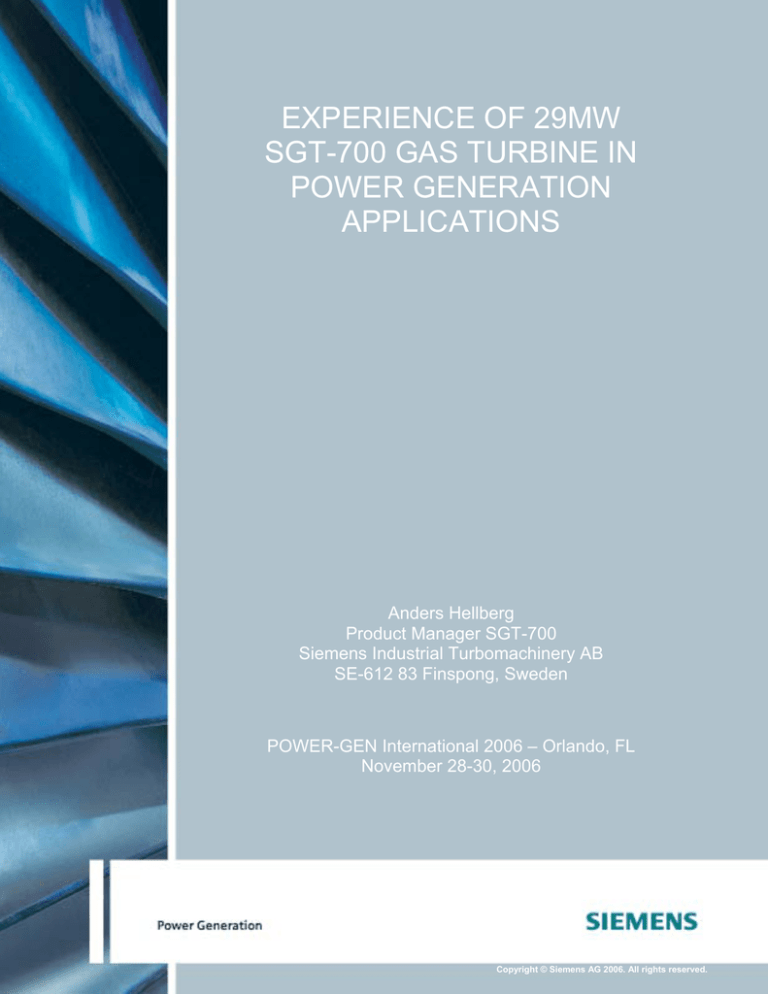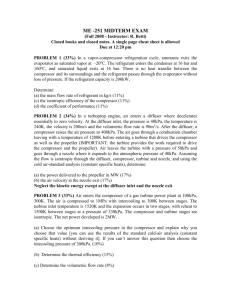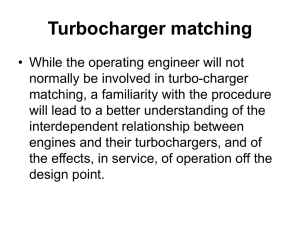
EXPERIENCE OF 29MW
SGT-700 GAS TURBINE IN
POWER GENERATION
APPLICATIONS
Anders Hellberg
Product Manager SGT-700
Siemens Industrial Turbomachinery AB
SE-612 83 Finspong, Sweden
POWER-GEN International 2006 – Orlando, FL
November 28-30, 2006
Copyright © Siemens AG 2006. All rights reserved.
Copyright © Siemens AG 2006. All rights reserved.
Abstract
This paper describes the testing and verification of Siemens gas turbine SGT-700 (formerly GT10C) and
the first phase of operation experience from this. Erection, commissioning and the first 10 000 hours in
commercial operation will be summarized.
Introduction
In 1997 the market requirement for a 30 MW industrial gas turbine was identified and an intensive
development was started, targeting an uprate of the twin shaft SGT-600 (formerly GT10B) at 25 MW to
create a gas turbine in the 30 MW range. The concept was based on the well-proven SGT-600 it but with
third-generation DLE (Dry Low Emissions) combustion technology from the SGT-800.
The commercial launch of the 30 MW unit took place in 1999 and the validation of the 30 MW unit started
in 2001. Until today (September 2006) a total of15 units have been sold. Seven units have been delivered to
site and all of them are now in commercial operation. Different applications are installed: power
generation, mechanical drive, onshore and offshore as well as single and dual fuel.
Commercial operation of the first units started in 2004. The two first sold SGT-700’s are owned by United
Gas Derivatives Company (UGDC) in Egypt. The Egyptian SGT-700’s have met all requirements of the
customer’s specification and have been running with a very high reliability, above 99.5%, which, of course,
is important for the success of our customer. Four SGT-700 have now passed their first 10 000 hours in
commercial operation.
The reason for the successful operation is the result of extensive development work and validation. There
we have used all competence, technology and methods available in order verify the SGT-700. The efforts
did not stop in the development phase: we have followed the gas turbine out in the field by having resident
engineers in place to help and educate our customers and to be able to feed back information quickly to the
development organization. The feedback from the field is the key to developing our processes and tools.
Main Features
The SGT-700 is derived from the SGT-600, see figure 1. The gas generator consists of inlet housing,
compressor, combustion system, compressor turbine, rotors and bearings.
Figure 1 SGT-700 versus SGT-600
Copyright © Siemens AG 2006. All rights reserved.
The inlet housing consists of a casing, which directs the incoming air to the compressor first stage and
which bears the guide vanes and the shroud ring carriers. The first two rows of guide vanes are variable,
actuated by a control mechanism and an electric actuator. There are two compressor bleed valves at the
second and the sixth stage. The compressor casing, covering the whole compressor section, is horizontally
split to facilitate servicing and replacement of components. The compressor rotor is built up from a number
of discs, electron beam welded together; the same technology and materials are used on both SGT-600 and
SGT-800. A diffuser section at the compressor discharge decelerates the flow and directs the air into the
combustion chamber. The SGT-700 gas generator rotor has the same overall length as the SGT-600, but
with eleven stages, as opposed to ten.
To increase power output the compressor flow has been increased from 79 kg/s to 90 kg/s compared with
SGT-600, the area of the inlet and first two stages having been increased by about 15%. To increase
efficiency a new compressor stage was added to raise the pressure ratio from 14.4 to 18, resulting in
slightly modified channel height from stage 4 to 11 as compared to stages 3 to10 in SGT-600. The flow
field in the new compressor is based on the SGT-600. However, the outlet velocity profile at the exit guide
vane was straightened to improve the pressure recovery of the compressor diffuser. The profiles of the new
compressor (based on SGT-800) have lower loss levels as well as a considerably wider working range than
the old double circular arc (DCA) profiles. The surge margin of the SGT-700 compressor has been verified
and is kept at the same level as with the SGT-600.
The environmental performance of the SGT-700 is state-of-the-art with its dual fuel DLE combustor. The
SGT-700 has the 3rd generation DLE, with the same burner as SGT-800. SGT-700 has 18 DLE-burners,
i.e. the same number of burners as SGT-600. The combustor design is based on that of the SGT-600 DLE
combustor. The annular combustor is made of Hastelloy-X sheet metal and has film-cooled liners with an
impingement-cooled front panel.
The experience from operation is that the SGT-700 can achieve NOx emissions below 15 ppmv (15% O2
dry) on gaseous fuel and 42 ppmv (15% O2 dry) on liquid fuel without any need for water or steam
injection.
The SGT-700, like the SGT-600, has a 2-stage air-cooled compressor turbine and a 2-stage uncooled power
turbine. The two-stage bolted compressor turbine module form a single shaft together with the electron
beam welded compressor rotor which rests in two standard hydrodynamic bearings of the tilting pad type
lubricated by mineral oil.
The separate high-speed (6500-rpm) two-stage power turbine also forms a single unit resting in two
standard hydrodynamic bearings of the same type as the gas generator rotor. The power turbine is then
coupled to a gear which is connected to the alternator.
Modularization, few parts, long component life and easy inspection ensure long time between overhauls
and low maintenance costs. To ensure this, operating experience gained from the SGT-600 has been
incorporated into the development of the SGT-700. The main focus of this development has been
concentrated on the core engine in order to improve performance and emissions further, while the design of
auxiliary systems has, to a large extent, been kept.
Compact package design for rapid installation
The SGT-700 shares the package with the SGT-600 and the installation of the turbines, see figure 2, meets
the market requirements for compactness, short erection and commissioning times and ease of
maintenance. The turbine is skid-mounted, with the auxiliaries grouped in self-contained modules placed in
the auxiliary room. The gas turbine driver layout is basically the same for all applications.
The gas turbine driver skid is built from steel beams and carries the gas turbine, auxiliary systems and
starter motor, with a total dry weight of approximately 78 metric tonnes. The gas turbine skid can then
either be bolted to the gear and alternator skid or be kept as a single driver package. The whole package can
also be designed to form a single-lift unit.
Copyright © Siemens AG 2006. All rights reserved.
3
4
5
2
7
6
1
A
E
F
B
C
D
G
8
9
H
10
J
I
12 13 14 15 16 17 18
K
19
20 21
22
11
23
L
M
O
N
P
24
1. Control room
2. Ventilation air inlet
3. Air inlet filter
4. Ventilation air outlet
5. Exhaust silencer
6. Gear
7. Gen. cooling, air outlet
8. Batteries
9. Lube oil unit
10.Fire suppress unit
11.Generator
12. Liquid fuel unit
13. Ignition gas bottles
25
26
14. Oil mist filter
15. Lube oil filter
16. Compressor wash unit
17. External gas unit
18. Air inlet plenum
19. Gas fuel unit
20. Purge air unit
21. Exhaust
22. Generator cooling, air inlet
23. Generator cubical box
24. Lube oil cooler
25. Starter motor
26. Seal air cooler
Figure 2 SGT-700 layout
Maintenance
The maintenance plan for the STG-700 and SGT-600 gas turbines is principally the same and well
established. As a basis for the maintenance activities Equivalent Operating Hours (EOH) is calculated in
the control system. The EOH is based on type of fuel, load and cycles. For a normal power plant operating
on continuous load it is possible to gain hours. A boroscope inspection is done every 10,000 EOH and
major overhauls at 40,000 and 80,000 EOH. A minor maintenance activity is carried out at intervals of
20,000 EOH. This basic maintenance plan should be adapted to a plant-specific operating profile, with
regard to, for instance, load cycles and influences from fuel and environment.
During a full 120,000 EOH cycle there is only 4% downtime for maintenance doing all maintenance at site.
And this can be reduced further: we have developed a method that allows us to replace the gas generator in
Copyright © Siemens AG 2006. All rights reserved.
24 hours, we can offer lease engines for planned maintenance and of course also time-saving alternative
work schemes.
In order to keep our customer’s cost for maintenance low, Siemens normally provide only the necessary
OEM specialists, while the customer himself supplies additional personnel.
To fulfill individual customer requirements, Siemens offer a comprehensive range of Long Term Service
Agreements (LTSA), from simple support agreements to agreements including both preventive and
corrective maintenance. Constituent elements in these agreements are 24-hour emergency phone support,
real-time remote connection to the customer’s control system, Condition Monitoring System (CMS) and
reduced fees for emergency spares and emergency lease units.
The SGT-700 has a number of features that simplify maintenance and inspection. Boroscope ports are
available on one side for inspection of the compressor stages, see figure 3. At the front of the air inlet
plenum, a door is fitted allowing access to the compressor. To access the hot section and power turbine the
gas generator can be rolled into the inlet, creating necessary space in between the compressor and power
turbine for maintenance activities.
The compressor casing has a horizontal split, allowing half of it to be removed for easy access to the rotor
and stator parts and an overhead crane is included in the package.
The combustion chamber can be inspected from boroscope access ports located at the end of the
combustion chamber. The burners can easily be dismantled for inspection or visual inspection of the
combustor chamber. The turbine can be inspected from the combustor and through three inspection ports.
Figure 3 Maintenance of SGT-700
An overhead crane is installed inside the gas turbine enclosure to facilitate maintenance and enough space
is available to allow operating personnel to walk around the machine. For flexibility, the gas turbine can be
removed from either side (to be selected) of the installation.
Copyright © Siemens AG 2006. All rights reserved.
Experience from operation
In November 2001 the first engine was started and passed through the first part of the validation process.
Complete disassembly and visual inspection of each component were standard procedure during this first
year to validate the design. Clearance and dimensional checks were performed to verify the design. During
disassembly/assembly the tools and working routines were also validated. The maintenance routines have
been improved and important assembly steps have been highlighted.
The SGT-700 passed a new milestone and entered commercial operation in 2004. 7 units around the globe
are at the moment in commercial operation in different applications and to date 4 units have logged over
10, 000 hours of operation.
Similar for the operation of each of seven units is that they are continuously operating units with few starts
and stops. The power generation units are mainly running at base load (100%). The common profile for the
operation of the mechanical drive units is that they are integrated in a larger infrastructure, which means
that availability and reliability are prioritized and the mechanical drive’s output margin included for the
process, deterioration etc. resulting in an operation on approximately 80-85% load.
Sochi, Russia
Sochi, the site of the first two SGT-700 power generation sets, delivered to JSC City Energo, Moscow, is
situated on the Russian coast of the Black Sea. The end customer is RAO UESR (Unified Energy System
of Russia) in Sochi, and the SGT-700’s are now installed in a the new 76 MW combined heat and power
plant, see figure 4, which provides power generation and district heating for the town of Sochi. Since Sochi
is one of Russia's major resorts on the Black Sea Coast there are high demands on the environmental
impact of the plant and, of course, the demand for uninterrupted power supply, which SGT-700 fulfils. The
plant is crucial for the area’s power supply, especially in the winter period. To ensure continuous operation
the units are equipped with dual fuel technology (liquid fuel operation as back-up). This shows the
importance of availability/reliability for the customer.
Figure 4 Sochi power plant
Together with the end user we have carried out planned extended inspections of the gas turbine. At the
level-A boroscope inspection a level-C inspection was made in order to verify different components in the
gas turbine. The results were very encouraging and no major issues were found.
Copyright © Siemens AG 2006. All rights reserved.
Port Said site, Egypt
Two identical trains for the United Gas Derivatives Company (UGDC) in Egypt were ordered in November
2002 for delivery to a natural gas liquids (NGL) plant in Port Said, Egypt, owned by UGDC, a specialpurpose company owned in equal parts by the Oil & Gas majors AGIP, BP Egypt and GASCO. Before
delivery from the workshop, the package (including driven compressor – also of Siemens manufacture) was
string-tested in Finspong, Sweden.
The plant is at sea level and its mechanical design is for an ambient temperature of 45°C. All equipment
and instrumentation is protected against the highly corrosive marine climate by tropicalization of electric
components. Because of the nature of the plant, environmental, health and safety considerations are
paramount in all aspects of the site work.
Installation is complete, and commissioning began in the summer of 2004. Both turbine-compressor sets
have been in commercial operation since the end of 2004 and deliver according to committed contracts.
During the one year warranty period, the average reliability was as high as 99.7% and the average
availability was 98.3%. This data includes two planned A-inspections at 2500 and 5000 hours, outside the
normal maintenance plan.
Oxy site, offshore Qatar
A platform with an SGT-700 installed for mechanical drive application has been built in Singapore and
transported to an offshore site off Qatar. The site has tough requirements and the engine must be able to
handle the hot and humid environment (+48°C) as well H2S in the fuel. Since December 2005 the unit is in
production and has logged over 5000 hours.
Eischleben site, Germany
In December 2003 Siemens received an order from Wingas for two SGT-700 compressor trains for a
pipeline compressor station in Eischleben, near Erfurt in Germany. This station is the terminus in Germany
of the Yamal pipeline, which originates in the Yamal peninsula in Siberia, and travels through Belarus and
Poland to Germany. From Eischleben the gas is distributed further to Germany and Western Europe
through existing pipelines. The units are operated as 1+1, one is always standby, To date they have looged
5000 hours of operation
Conclusion of operation statistics
As of September 2006 approx. 55 000 running hours have been accumulated from the above-mentioned
units. The fleet leader is at approximately 15 000 operation hours. Four units are above 10 000 hours and
The SGT-700 has proven to be a reliable gas turbine producing power in various applications and under
different ambient conditions.
Summary
The SGT-700 is derived from the SGT-600. Despite this, thorough tests have been performed in the test
facility in Finspong, Sweden, in order to secure high reliability and availability for the customers.
In addition to this, extra inspections of some of the units have been made after 2000-10 000 hours in order
to be sure that no surprises have appeared. All inspections have shown that no unexpected issues have
arisen – the core engines are in very good condition. This is also shown by the high figures on availability
and reliability where the values are extremely high for a new engine.
The next step is to continue with the inspections as planned and use data from CMS (Condition Monitoring
System) which will be collected on all the engines in order to follow the fleet and maintain high availability
and reliability.
SGT-700 has, in its first years of operation proved to be a reliable high efficient gas turbine in various
applications.
Copyright © Siemens AG 2006. All rights reserved.



